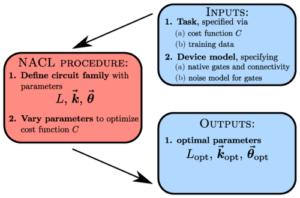
Quantum technologies seem poised to disrupt the world of high-performance computing, but developing – and stabilizing – the technology itself poses serious computing challenges. Researchers at Los Alamos National Laboratory are using machine learning to help manage harmful disruptions in quantum computers, allowing them to perform more reliably in the real world.
Quantum bits (qubits) sometimes interact in strange ways, producing noisy interference that causes the qubits to falter within millionths of a second. Cumulatively, these errors end up causing a significant amount of noise and producing serious losses in accuracy and efficiency. In the past, researchers have ameliorated the errors by, in essence, reducing opportunities for the qubits to interact with one another.
By way of contrast, this method, called noise-aware circuit learning (NACL), uses machine learning to train the quantum circuits to recognize the noise of that specific quantum computer, and thus, teach itself to ignore that noise. The researchers likened the resulting algorithm to a vaccine teaching the body to resist certain pathogens by exposing it to them – but unlike a vaccine, NACL can select from a wide menu of noise reduction techniques and apply them where necessary.
“In this new research, we let the computer discover what’s best,” explained Patrick Coles, a quantum physicist at Los Alamos and lead author of the paper. “In essence, we say, ‘Computer, please find the best strategy for making a resilient circuit.’ We found the computer discovers strategies that make sense to us. … [NACL] will play an important role in the quest for quantum advantage, when a quantum computer solves a problem that’s impossible on a classical computer.”
The researchers tested NACL by first modeling the noise of a selected quantum computer, training the ML model on that data, and testing the results on the actual quantum computer in question.
“Our work automates designing quantum computing algorithms and comes up with the fastest algorithm tailored to the imperfections of a specific hardware platform and a specific task,” added Lukasz Cincio, a quantum physicist at Los Alamos and co-author of the paper. “This will be a crucial tool for using real quantum computers in the near term for work such as simulating a biological molecule or physics simulations relevant to the national security mission at Los Alamos.”
For now, NACL is being tested on and developed for intermediate-scale quantum computers. “For the future, it will be important to figure out how to scale NACL to develop noise-resilient circuits for larger devices,” Coles said.


You must be logged in to post a comment.